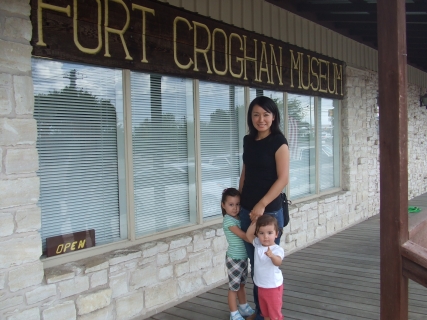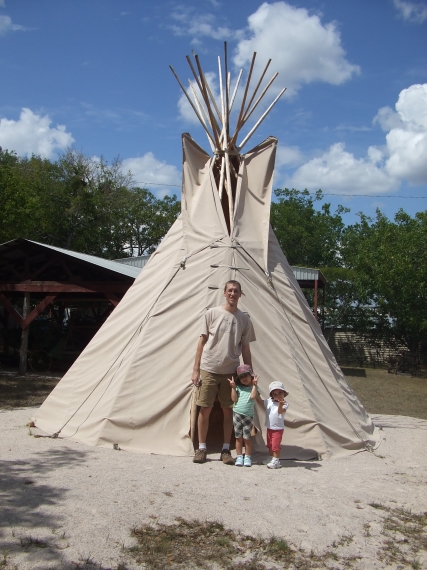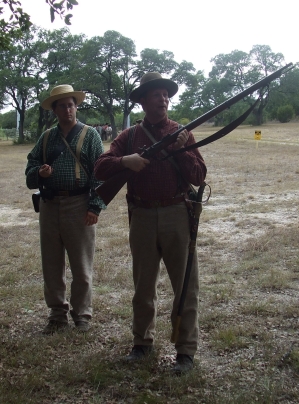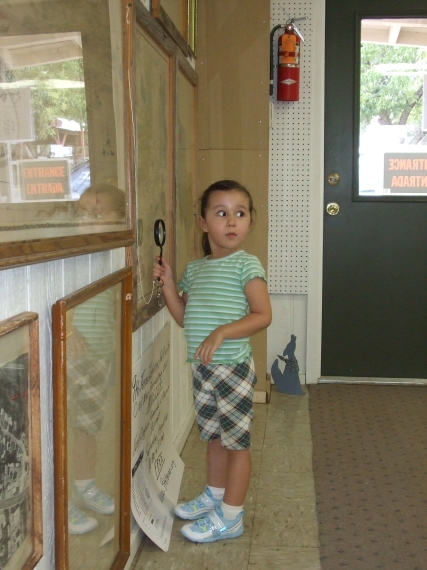Last Saturday Ryoko wanted to get out of the house and go somewhere. This is actually harder than it seems. It being August in Texas, it’s 95 to 100 degrees every day, the only exception being if it happens to rain. Ryoko has very sensitive skin and being out in the hot sun for more than just a few minutes causes her to break out into a rash that takes weeks to clear up using both topical and ingested medicines. So anything outdoors is pretty much out until October at the earliest. Indoors, well, there aren’t so many options. There are a few museums and such, but all the free ones we’ve been to multiple times and we’re a little bored of them. There is a place that is an indoor play area for children, but it’s pretty steep – $3.00 per child under 3, and $7.50 per child 3 and over. That’s $10.50 just to have an indoor place to play, way beyond our budget.
So I looked a bit on the internet and found a place not too far where we hadn’t gone before: Burnet, TX. It’s maybe a half-hour drive to the northwest, and it has a small museum where a fort had been there back during the 1850’s.
There are a lot of period buildings in the compound, but due to the weather we mostly stayed inside the main building and looked at the artifacts in there. It is a small quaint little museum, reminiscent of the kind of places your class might go on a school field trip when you were in kindergarten or 1st grade.

(click for larger image)
Still, there were many very interesting artifacts there, even if a lot of them really didn’t have much to do with the frontier period of central Texas. If I had to guess a theme for the inside of the museum, it was “This is everything donated by the community that’s over 100 years old that we thought might be interesting to display.” There were two old pianos, a Model T Ford that served as an ambulance in WWI, samples of old barbed wire, many Indian arrow heads, lots of period clothing, old typewriters, on old telephone switch board, a hand printing press, a loom, spinning wheels, old maps, etc. etc.
Very coincidentally, the day we visited happened to be the day that the local civil war re-enactment group was having their muster. We went outside for a few minutes to see what was up. There was an Indian tepee which didn’t really seem to fit, but Ryoko thought it was novel so we took a picture.

Sure enough, there was a line of men with muskets marching:

(click for larger)
So this being Texas, they were a regiment for the Confederate army. I was curious why they didn’t have the trademark grey uniforms, but it turns out that during the war, the south was so strapped for cash that most soldiers didn’t even have uniforms. After the men gathered in some shade under a tree (remember it’s 95~100 degrees out, around 70% to 80% humidity), the captain (only distinguishable by his ownership of a sword) took one of his soldiers with him to give the onlookers a bit of explanation and a demonstration of the musket.

(click for larger)
(I personally thought the captain looked a lot like Chris Cooper, but maybe that’s just me) The soldier demonstrated how to load and fire the musket. It was interesting to see the slight technological changes that the musket had gone through since revolutionary war times. They are:
1.) Pre-measured powder packets wrapped in paper. The soldier had a satchel on his side with 40 or so of these packets with equal number of of lead balls. Loading consisted of grabbing a powder packet, biting the tip off, pouring the powder in the muzzle, dropping in a ball, then ramming it down.
2.) Mercury fulminate percussion caps that allowed for reliable firing, even when wet. After loading the powder and ball, a percussion cap was placed below the pin, and then the gun was ready to fire once the hammer was cocked.
That was all I noticed. They still didn’t have rifling, breech-loading, or single-unit ammunition (i.e. the gunpowder and bullet pre-assembled in one unit, what we think of today as ammunition).
So we went back inside (Ryoko was getting uncomfortable, and there were several bees that were far too interested in us) where we looked at the exhibits some more. Then I noticed something that I’ll talk about in my next post.
Finally, here’s a picture of Karisa looking at some of the maps on the wall:


The kids look great. Well, everyone looks great actually. I know just what you mean about being impossible to go outside and cabin fever inside. Ours happens in the during the winter months rather than the summer. (but winter lasts from October until the end of April). Good job getting out and seeing some culture.
Have you guys been down San Antonio way yet? It’s like 3ish hours from you I think. It is a wonderful place full of things to do, but definitely an october trip.